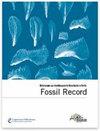下载PDF
{"title":"Temporal patterns in disparity and diversity of the Jurassic ammonoids of southern Germany","authors":"Marc S. Simon, Dieter Korn, Stefan Koenemann","doi":"10.1002/mmng.201000016","DOIUrl":null,"url":null,"abstract":"<p>A morphometric analysis of the characteristic whorl cross-sections of 1,200 Jurassic ammonoid species from southern Germany enabled us to characterise their morphospace. The successive Jurassic ammonoid faunas of southern Germany show characteristic patterns in morphospace occupation. While Early and Middle Jurassic ammonoids occupy limited areas of the morphospace range, the Late Jurassic ammonoids cover the entire spectrum. The ammonoids are characterised by an overall increase of both taxonomic diversity and morphological disparity in the course of the Jurassic. Strong fluctuations occur until the middle Late Jurassic, followed by a diversity decrease in the early Kimmeridgian and a disparity reduction in the early Tithonian. While diversity and disparity show similar progression during most of the Early Jurassic, they diverge subsequently and show only poor correlation until the end of the Jurassic. Particularly in the Middle Jurassic diversity and sea level changes correlate strongly. Neither temporal patterns in diversity nor disparity support the hypothesis of a mass extinction event in the early Toarcian. Significant changes in diversity and disparity in the early Callovian support a putative migration event of Boreal ammonoids into the Tethyan realm. (© 2011 WILEY-VCH Verlag GmbH & Co. KGaA, Weinheim)</p>","PeriodicalId":55147,"journal":{"name":"Fossil Record","volume":"14 1","pages":"77-94"},"PeriodicalIF":1.4000,"publicationDate":"2011-02-22","publicationTypes":"Journal Article","fieldsOfStudy":null,"isOpenAccess":false,"openAccessPdf":"https://sci-hub-pdf.com/10.1002/mmng.201000016","citationCount":"13","resultStr":null,"platform":"Semanticscholar","paperid":null,"PeriodicalName":"Fossil Record","FirstCategoryId":"89","ListUrlMain":"https://onlinelibrary.wiley.com/doi/10.1002/mmng.201000016","RegionNum":4,"RegionCategory":"地球科学","ArticlePicture":[],"TitleCN":null,"AbstractTextCN":null,"PMCID":null,"EPubDate":"","PubModel":"","JCR":"Q3","JCRName":"Earth and Planetary Sciences","Score":null,"Total":0}
引用次数: 13
引用
批量引用
Abstract
A morphometric analysis of the characteristic whorl cross-sections of 1,200 Jurassic ammonoid species from southern Germany enabled us to characterise their morphospace. The successive Jurassic ammonoid faunas of southern Germany show characteristic patterns in morphospace occupation. While Early and Middle Jurassic ammonoids occupy limited areas of the morphospace range, the Late Jurassic ammonoids cover the entire spectrum. The ammonoids are characterised by an overall increase of both taxonomic diversity and morphological disparity in the course of the Jurassic. Strong fluctuations occur until the middle Late Jurassic, followed by a diversity decrease in the early Kimmeridgian and a disparity reduction in the early Tithonian. While diversity and disparity show similar progression during most of the Early Jurassic, they diverge subsequently and show only poor correlation until the end of the Jurassic. Particularly in the Middle Jurassic diversity and sea level changes correlate strongly. Neither temporal patterns in diversity nor disparity support the hypothesis of a mass extinction event in the early Toarcian. Significant changes in diversity and disparity in the early Callovian support a putative migration event of Boreal ammonoids into the Tethyan realm. (© 2011 WILEY-VCH Verlag GmbH & Co. KGaA, Weinheim)
德国南部侏罗纪菊石差异和多样性的时间格局
对德国南部1200个侏罗纪类氨物种的特征螺纹截面进行形态计量学分析,使我们能够表征它们的形态空间。德国南部连续的侏罗纪氨类动物群在形态空间占据上表现出独特的模式。早侏罗世和中侏罗世的菊石只占形态空间范围的有限区域,而晚侏罗世的菊石则覆盖了整个光谱。菊石的特点是在侏罗纪时期分类多样性和形态差异总体上都有所增加。强烈的波动一直持续到晚侏罗世中期,随后是基默里纪早期的多样性减少和泰托尼世早期的差异减少。在早侏罗世的大部分时间里,多样性和差异性表现出相似的发展趋势,但随后分化,直到侏罗世末期才表现出较差的相关性。特别是在中侏罗世,生物多样性与海平面变化密切相关。多样性和差异的时间模式都不支持托瓦纪早期大灭绝事件的假设。早卡略世的多样性和差异的显著变化支持了北方菊石向特提斯王国迁移的假设事件。(©2011 WILEY-VCH Verlag GmbH &KGaA公司,Weinheim)
本文章由计算机程序翻译,如有差异,请以英文原文为准。


